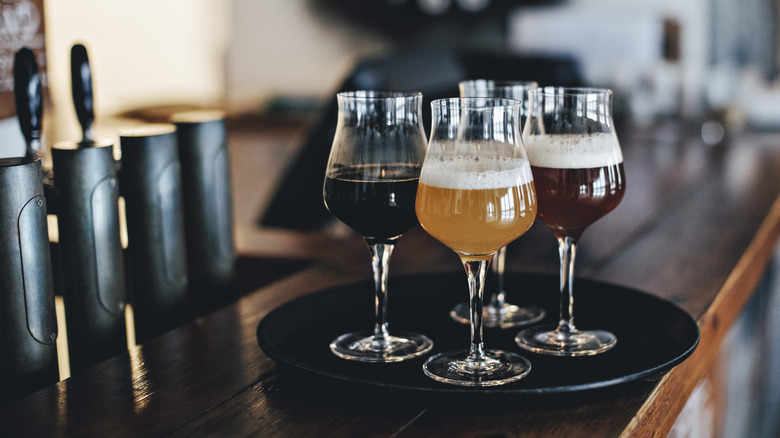What Is Domestic Beer, And How Is Craft Beer Related?
Beer is a beverage that exists in many contexts. It can be anything from a cold can sipped at an American sports event to a centuries-old style crafted by Trappist monks in Belgium. With such an evolution since it was created by mistake, it's no surprise beer lovers attach terms to categorize the offerings.
Take a domestic, which simply means a beer made in the same country it's consumed. Meant to contrast an import, the term embraces a large assortment of beers you'll see at the store, or in a bar or eatery. Meanwhile, a craft beer alludes to a brew with more specific criteria. The term references innovative beer styles made by independent brewers, offered on a smaller scale.
By strict definition, all American-made craft beer is also domestic. However, as many American bargoers note, domestic and craft beers are often listed separately on menus. The former are usually cheaper, more recognizable names, while the latter promises a more flavorful experience. Most likely, it's a relic from when imported European beers were the go-to elevated option, while the American option was a macro, or mass-produced, beer, like Budweiser or Coors. However, since then, the market's changed, adding to subjective confusion between the two terms.
Domestic often denotes affordable and accessible beers
A domestic beer is defined as a brew crafted in the same country as it is sold. Most often, it's what you'll see at the local convenience store or as the draft available at the bar. Its ubiquity is pragmatic — local production means easier distribution, no import taxes, and hopefully a fresher taste. The most popular examples in the U.S. include favorites like Budweiser and Coors Light, although the concept of domestic beers is applicable abroad, too. XXXX beer is Australia's pride and joy, while Guinness is Ireland's national drink.
Technically, any craft beer made in the U.S. also fits such criteria. However, the term domestic has often become interlinked with what's called a macro: a large volume, industrially produced, and easy-drinking offering. Such large-scale domestics occupy the majority of the market share in the U.S., and are split among just a handful of companies. Such market dominance comes with lower prices.
However, there's also a category of more regional beer styles, that occupy a realm of affordability, but with distribution practices that are not quite as wide-ranging. Cult favorites like Genesee Cream Ale and Anchor Steam represent dependable brews to a more select area. And with the quickly expanding popularity of Mexican beer in the U.S., the go-to offering is changing. As a result, the delineation of domestic and import is losing relevance.
The modern craft beer scene is reigniting local consumption
Craft beer may evoke associations of experimental IPAs and crazy sours, but investigate the term precisely, and the boundary becomes hazy. It carries no legal regulation, although the Brewers Association trade group does offer some guidance. It states that a craft producer makes under six million barrels annually, with less than 25% of the business stake to be held by a non-brewer. Nevertheless, this doesn't neatly categorize all brews, evidenced by how many labeled craft beers are connected to Anheuser-Busch. So understanding the dominance of only a few select brewers — and the rise of established domestics — requires looking back through history.
Before the Prohibition era, multiple breweries operated in the U.S., brewing predominantly ales and lagers. Especially at first, these remained very local and small-scale operations, crafting fresh beers served in nearby pubs. However, in the 20th century, Prohibition forced their closure, eliminating many producers. Afterward, federal laws mandated a new distribution system that complicated sales to bars.
Large-scale producers like Pabst and Coors grew to dominate the market, cementing the name-brand beers as the go-to options. By the 1970s, there were only 45 independent breweries stateside. The expansion of craft beer is once again bringing small-scale beer production back into the spotlight. Today, more than 9,000 craft brewers operate in the U.S., making it easier to sip on an offering that's not just domestic, but local, too.


